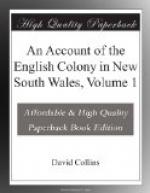In an excursion to the westward with a party, we passed a tree (of the kind named by us the white gum, the bark of which is soft) that we judged to be about one hundred and thirty feet in height, and which had been notched by the natives at least eighty feet, before they attained the first branch where it was likely they could meet with any reward for so much toil.
The features of many of these people were far from unpleasing, particularly of the women: in general, the black bushy beards of the men, and the bone or reed which they thrust through the cartilage of the nose, tended to give them a disgusting appearance; but in the women, that feminine delicacy which is to be found among white people was to be traced even upon their sable cheeks; and though entire strangers to the comforts and conveniencies of clothing, yet they sought with a native modesty to conceal by attitude what the want of covering would otherwise have revealed. They have often brought to my recollection, “The bending statue which enchants the world,” though it must be owned that the resemblance consisted solely in the position.
Both women and men use the disgusting practice of rubbing fish-oil into their skins; but they are compelled to this as a guard against the effects of the air and of mosquitoes, and flies; some of which are large, and bite or sting with much severity. But the oil, together with the perspiration from their bodies, produces, in hot weather, a most horrible stench. I have seen some with the entrails of fish frying in the burning sun upon their heads, until the oil ran down over their foreheads. A remarkable instance once came under my observation of the early use which they make of this curious unguent. Happening to be at Camp Cove at a time when these people were much pressed with hunger, we found in a miserable hut a poor wretched half-starved native and two children. The man was nearly reduced to a skeleton, but the children were in better condition. We gave them some salted beef and pork, and some bread, but this they would not touch. The eldest of the children was a female; and a piece of fat meat being given to her, she, instead of eating it instantly as we expected, squeezed it between her fingers until she had nearly pressed all the fat to a liquid; with this she oiled over her face two or three times, and then gave it to the other, a boy about two years of age, to do the like. Our wonder was naturally excited at seeing such knowledge in children so young. To their hair, by means of the yellow gum, they fasten the front teeth of the kangaroo, and the jaw-bones of large fish, human teeth, pieces of wood, feathers of birds, the tail of the dog, and certain bones taken out of the head of a fish, not unlike human teeth. The natives who inhabit the south shore of Botany Bay divide the hair into small parcels, each of which they mat together with gum, and form them into lengths like the thrums of a mop. On particular occasions




